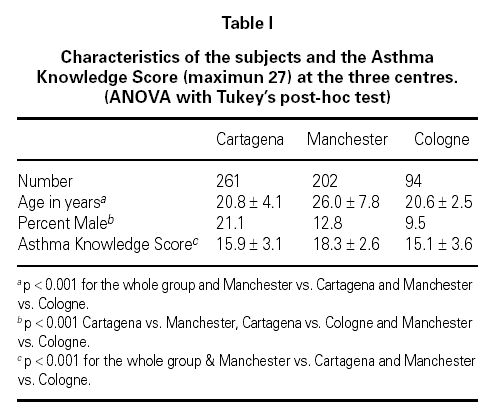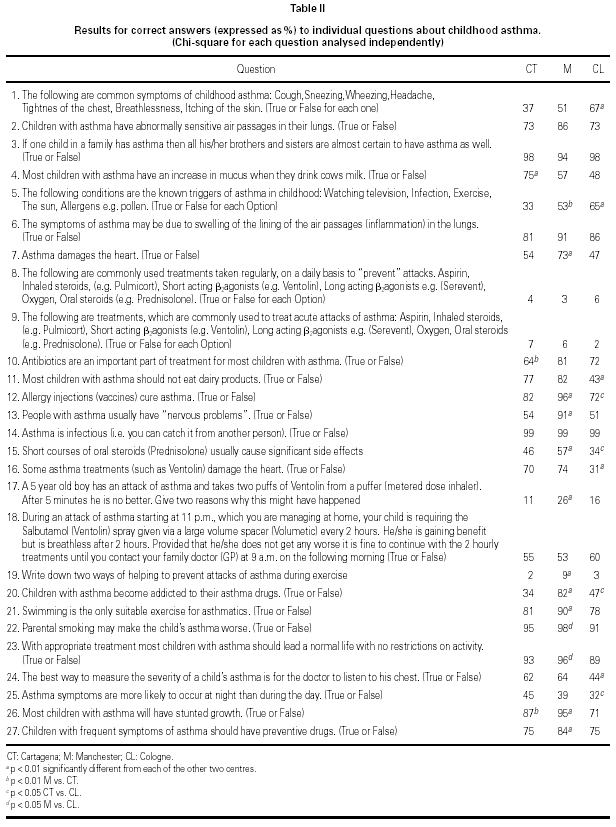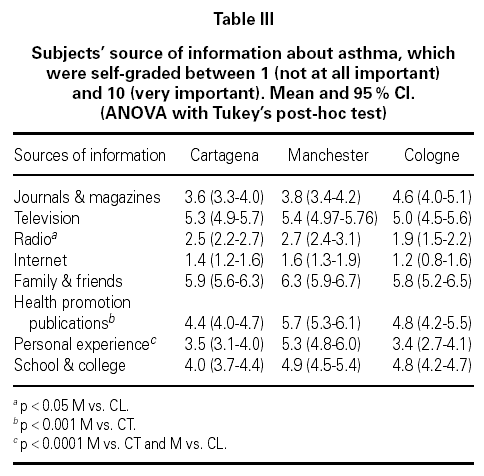INTRODUCTION
Asthma is recognised in industrialised countries as the most common chronic disease of children1. The International Study of Asthma and Allergies (ISAAC)2 data have shown marked differences in the prevalence of childhood asthma in European countries. To our knowledge there are no studies that have evaluated differences in knowledge about childhood asthma and the sources of information among subjects living in different countries with different asthma prevalence rates. The objective of this study was to determine knowledge about childhood asthma among young educated subjects living in Spain, the UK and Germany, where the disease prevalence is 10 %, 30 % and 14 %, respectively1. The study also sought the determine sources of the subjects asthma knowledge. We hypothesised that knowledge about childhood asthma would be better among subjects from the UK, because of it's higher childhood asthma prevalence rate.
METHODS
This cross-sectional study was undertaken at Schools of Nursing in Cartagena and Murcia (Spain), Manchester (UK) and Cologne (Germany), in 1999. The subjects were first year nursing students, who were invited to take part in this study, which involved completing a written questionnaire, during the first week of their training. We chose this sample at this particular moment when the subjects had no received specific training about asthma yet for two reasons: it would offer us an insight of the knowledge of the disease among high educated individuals of that age, and it could be used as a baseline for future comparisons on successive years of training. The study was approved by the relevant Research ethics committees at the three Schools of Nursing.
A previously validated written childhood asthma knowledge questionnaire3,4 was used for this study. Minor modifications were made to update the questionnaire in order to reflect changes in asthma management, i.e long acting β2agonists were included among the asthma medications; the answers to three questions that were originally open, were closed; and one question about asthma prevalence was omitted. Subjects were asked to select true or false answers to specific questions about the disease and it's treatment, and provide written answers two short open-ended questions. Additional new questions were added in order to gather the information about subjects' demographic data and their sources of knowledge about childhood asthma, e.g. their relations and friends. The questionnaire was translated from English into Spanish and German languages and then back translated into English. Questionnaires were distributed and self-completed while the students were in class.
The statistical analyses were performed using the SPSS software, version 10 (SPSS Inc., Chicago, IL, U.S.A.) for Windows. The normally distributed data are shown as mean +/SD. The mean asthma knowledge score for the three centres were analysed using analyses of variance and Tukey's test was used for comparisons between the centres. The responses to questions were categorised as percentage of right answers and compared using the Chi2 statistic. Each question was considered independent and when a significant test was encountered in a specific question, a post-hoc analysis was performed calculating the value of Chi between pairs of centres. Association between the mean asthma knowledge score and subjects' self-rated score for the importance of information source were examined using Pearson's correlation. Significance was accepted at p < 0.05 level.
RESULTS
The participation rate was over 95 % in the three cities. The mean age, percentage of male subjects and mean asthma knowledge scores of subjects at three sites are presented in table I.
The nursing students from Manchester were significantly older than those at Cartagena and Cologne, and age was weakly related to asthma knowledge score (r = 0.11, p = 0.07). The nursing school at Cartagena had significantly more male students than at Manchester and Cologne. The mean asthma knowledge score significantly differed in the three centres (p < 0.01), with the score being higher among Manchester students compared with those at Cartagena and Cologne. The gender did not influence the score in any centre.
The results for correct answers to individual questions about asthma, for subjects at each of three nursing schools are presented in table II. Questions on inheritance, infectiousness of asthma, inflammation, increased sensitivity of the air passage, the role of immunotherapy, swimming being the only suitable sport, adverse effect of parental cigarette smoking, that most treated asthmatic children live a normal life with no restrictions on activities, effect of asthma on growth and on the important role of preventive treatment in those with frequent symptoms were consistently good (> 70 % correct) among subjects at three centres. In contrast, answers to questions on medications used to treat acute exacerbations of asthma and those used to reduce the risk of future exacerbations were consistently poor (< 30 % correct) among subjects at three centres.
The knowledge about common symptoms of childhood asthma was significantly better among students from Cologne than those from Cartagena and Manchester. More than 40 % of students from Cologne and Manchester but only 25 % of those from Cartagena thought that cow's milk increased mucous production. The knowledge about common triggers of asthma was better significantly among Cologne and Manchester students. Students from Cologne were more likely to believe that asthma itself or it's treatment with salbutamol (Ventolin) damaged the heart. Students from Cartagena were more likely to believe that antibiotics had an important role in the treatment of childhood asthma. Significantly more students from Cologne believed that children with asthma should not eat dairy products than those from Cartagena and Manchester. More than 40 % students from Cartagena and Cologne but only 9 % from Manchester felt that asthmatic children had "nervous problems". Students from Cartagena and Cologne were more likely to believe that children with asthma were more likely to become addicted to their asthma drugs.
Subjects' sources of information about asthma and their relationship to their asthma knowledge score are shown in table III. For subjects at all three centres, the most useful important sources of information (score > = 5) were family and friends and television. Students from Manchester rated asthma information from health promotion publications and personal experience more highly than other sources of information (table III). For subjects at all three centres, only knowledge gained from personal experience was significantly associated with the asthma knowledge score (r = 0.27, p < 0.001).
Ten subjects (all from Manchester) mentioned in their questionnaires having gained information about childhood asthma through their own child/children's experience of the disease. The mean asthma knowledge score of these 10 subjects was 20.8 +/1.9 which was significantly (p < 0.005) better than that of rest of the Manchester students (18.2 +/2.5).
DISCUSSION
To the best of our knowledge this is the first study that has assessed knowledge and health beliefs about asthma among young educated subjects living in three European countries. We chose nursing students for two reasons: it would offer us an insight of the knowledge of the disease among high educated individuals of a similar age, and it could be used as a baseline for future comparisons on successive years of training. We recognize that the chosen population, being previously interested in health issues, could offer higher standards of disease knowledge than other similarly educated group of individuals, like engineering students.
The mean asthma knowledge score of Manchester students was significantly higher than those at Cartagena and Cologne nursing schools. There are several possible explanations for this. The ISAAC study results have shown that the UK has one of the highest prevalence of childhood asthma in the world2. Thus, the higher prevalence of asthma in the UK might be one reason for the better asthma knowledge score of Manchester students. While our questionnaire did not contain a specific question about subjects' personal history and experience of childhood asthma (an information that could not be retrieved afterwards), the ISAAC asthma prevalence makes it more likely that many more of Manchester students are likely to have suffered from childhood asthma centres. Further, indirect support for this thesis comes from our finding that knowledge gained from personal experience was significantly associated with the subjects' asthma knowledge score. The Manchester nursing students were significantly older than those at Cartagena and Cologne nursing schools. Thus it is possible that maturity and more "life experiences" of Manchester Students contributed to their higher asthma knowledge score. In fact, age of subjects was related to asthma knowledge score in simple correlation analyses. It is noteworthy that ten subjects from Manchester who mentioned their own child/children's experience of asthma had significantly better asthma knowledge scores than that of rest of the Manchester students. Unfortunately, our questionnaire did not contain a specific question about asthma in offspring of the subjects', but it is possible that older Manchester cohort were more likely to have children than students at Cartagena and Cologne. We believe that this factor might have also contributed to better asthma knowledge scores of Manchester students. Finally, it is possible that Students in Manchester have had a greater exposure to public health education campaigns about asthma. Support for this thesis comes from our finding that students from Manchester regarded information from health promotion publications as one of the two most important sources of information about the condition.
It was reassuring that knowledge about childhood asthma and it's treatment was satisfactory (total score > 70 %) for 10 out 27 questions about the disease, among students at the three centres (table II). However, interesting differences in responses were observed among students according to country of residence. For example, students from Cologne were more likely to believe that asthma itself or it's treatment with salbutamol (Ventolin) damaged the heart. This belief, in part is likely to stem from the tachycardia that commonly occurs with b2agonists, such as salbutamol, when they are used for treatment of acute exacerbation of asthma.
More students from Cologne or Manchester than Cartagena thought that cow's milk increased mucous production. This might be due to the ambiguity in interpretation of the question so that it might have been confused with allergy to cow's milk. Students from Cologne provided more false answers to the question that most children with asthma should not eat dairy products. This might be due to a strong health belief that asthma is predominantly an allergic rather than an inflammatory condition. Significantly more students from Cartagena and Cologne felt that asthmatic children had "nervous problems". This might in part be due to an agitated and confused appearance of a hypoxic patient with severe exacerbation of asthma. Widespread usage of "over the counter" bought antibiotics in Spain probably explains why the students from Cartagena were more likely to believe that antibiotics had an important role in the treatment of childhood asthma. It is matter of some concern that Students from Cartagena were more likely to believe that children with asthma were more likely to become addicted to their asthma drugs. This response suggests compliance with preventative therapy with inhaled steroids, long acting β2agonists, which are the mainstay of therapy in children with moderate to severe asthma, might be poor in Spain. Further studies are needed to explore the reasons for this belief.
Clearly, there are several shortcomings and limitations of the study. As mentioned before, no question that asked if subjects had their own children and whether they were asthma sufferers. There was also failure to include a question on subject's personal history of asthma. Based on the ISAAC data, it is likely that more students from Manchester had suffered from childhood asthma symptoms. In spite of these limitations, this study has provided novel information about knowledge of, and beliefs about childhood asthma among young educated people brought up Spain, the UK and Germany. As mentioned above answers to some of the questions such as asthma or it's treatment damage the heart and patients are at risk of becoming addicted to asthma medications need addressing through the nurse training curriculum and health promotion for the general public. It will be interesting to see if the knowledge scores of this cohort of students, determined by the same questionnaire, improves as they progress through their nurse training.
In conclusion, results of our study has provided "base-line" knowledge about childhood asthma among educated young adults about to embark on their nursing training and career, and could help to find ways to improve asthma knowledge among the general population. Our data also provide a unique insight into health beliefs about the commonest chronic childhood illness, among young adults living in Spain, the UK and Germany.










